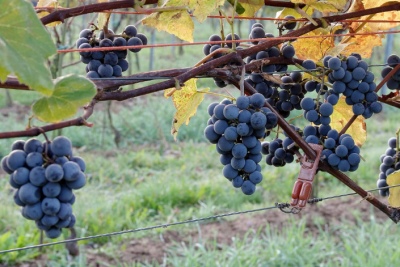
- Authors: USA
- Appointment: universal
- Berry color: Navy blue
- Ripening period: mid-late
- Ripening period, days: 186
- Frost resistance, ° C: -30
- Name synonyms: Bull's Seedling, Varatura, Dalmadin, Ripadella, Ripatella, Ripotella, Ripertella, Fekete Noah
- Flower type: bisexual
- Density of the bunch: medium and dense
- Skin: thick
Concorde is a popular grape variety that is highly valued for its excellent taste and some of the characteristics of agricultural technology. Gardeners are also attracted by the high yield of the plant. Let's take a closer look at the Concorde variety.
Breeding history
For the first time, the introduced variety was bred by US breeders. Catawba and Vitis Labrusca are considered to be its "parents".
Description
The vigorous vine of the liana-like type is characteristic of the Concord variety. The leaf is large, slightly dissected and abundantly covered with pile on the lower part. Shoots ripen actively and simultaneously.
Ripening period
The presented variety belongs to the mid-late varieties, the first berries can be enjoyed 186 days after bud break.
Bunches
The bunch is characterized by a conical shape with one or two wings. Its density is medium, its size is small, its weight is about 120 g.
Berries
The fruits have a dark blue thick skin, the pulp has a "fox" aroma and is separated by a "pouch". The berries are round in shape, the size is medium.
Taste
Taste properties are assessed in different ways. Someone feels a bright isable aftertaste, someone feels strawberry notes, and for some it's just sugary sweet berries.
Yield
Concord is a high-yielding variety. Judging by the gardeners' reviews, you can get 6-8 buckets of harvest from one bush.


Growing features
Concorde is very vulnerable to watering. So, to preserve moisture, it is important to mulch the soil even at the planting stage. However, even with waterlogging of the soil, problems can arise, for example, plant disease. Therefore, when watering, you should observe the golden mean. It is important to prevent the use of spray agents.
The first feeding is done in the third year of life, usually growers recommend applying organic fertilizers. Next year, mineral supplements will also become relevant, it is better to add them in the form of solutions.
And also when leaving, it is important to regularly weed the soil around the bush.
Landing
Best of all, the culture will develop on light fertile soil. If planting is carried out on poor land, then when planting, a layer of earth should be mixed with rotted manure, broken brick and mineral mixtures.
For this variety, a planting pit with a size of 100x100 cm is suitable.In group planting, the distance between seedlings should not be less than 2 m.If a drainage pipe is placed during planting, this will simplify the processes of watering and feeding the plant.

Pollination
The concord has a bisexual flower type, so it does not need the proximity of other pollinator varieties.
Pruning
Typically, the presented variety is grown in an arched way, so formative pruning is carried out under the arch. However, the bush itself often grows in this way, this is inherent in its nature, therefore, formative pruning is not always required, which cannot be said about sanitary pruning. In the fall, it is carried out 2-3 weeks after the leaves fly around, and in the spring - before the buds open. During the event, it is required to remove dried, old or damaged branches.



Frost resistance and the need for shelter
The variety has high frost resistance, it is able to withstand temperatures up to -30 degrees without shelter.

Diseases and pests
Fungi infrequently infect the Concord variety, but the culture's resistance to mildew is estimated at 3 points, which means that you need to take care of protecting the plant from this ailment. Fungicides are suitable for processing. But the wasps are not afraid of the plant, since they are not interested in a dense skin with a wax coating.

If the grapes are exposed to any disease or insect, this is always reflected in its appearance.
Storage
Bunches are stored for a long time both on the bush and in the cellar. After harvesting, it is important to put the crop in boxes and put it in the cellar, in this form they can lie for 30-60 days without losing their presentation. Berries even improve their palatability when lying down. Bunches of this variety are distinguished by good transportation.











































































